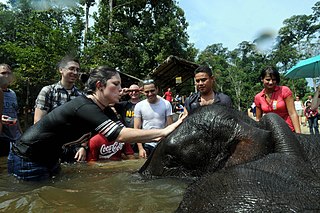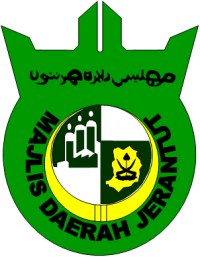
Taman Negara is a national park in Peninsular Malaysia. It was established in 1938 and 1939 as the King George V National Park after Theodore Hubback lobbied the sultans of Pahang, Terengganu and Kelantan to set aside a piece of land that covers the three states for the creation of a protected area. After independence, it was renamed Taman Negara, which means "national park" in Malay.

The Pahang River mainly flows through the state of Pahang, Malaysia. Its drainage basin covers its Pahang as well as the neighbouring state of Negeri Sembilan.

Temerloh is a municipality in central Pahang, Malaysia. Located about 130 kilometres (81 mi) from Kuala Lumpur along the Kuantan–Kuala Lumpur trunk road, Temerloh is the second largest urban area in Pahang after Kuantan, the state capital city. It is situated at the confluence of the Pahang and Semantan Rivers. Today, Temerloh usually refers to the territory under the administration of Temerloh Municipal Council which includes Mentakab, Lanchang, Kuala Krau and Kerdau.
Raub is a town in Raub District, Pahang, Malaysia. Raub is one of the oldest towns in Pahang.
The East Coast Expressway is an interstate controlled-access highway running parallel to the northeastern coast of Peninsular Malaysia. The currently operational 433-kilometre (269-mile) segment of the expressway runs through Karak, Pahang and Kuala Nerus, Terengganu.

The Jerantut District is a district in north-eastern Pahang, Malaysia. Jerantut is home to the National Park.

Segambut is a sub-district in Kuala Lumpur, Malaysia. The federal constituency represented in the Dewan Rakyat is Segambut.

Setapak is a town and mukim straddling both norteastern Kuala Lumpur and Gombak District of Selangor, Malaysia.
Ishak Haji Muhammad, better known as Pak Sako, was a Malaysian writer, active in the 1930s until the 1950s. He was a nationalist and his involvement began before independence and continued thereafter. He fought for the idea of the unification of Melayu Raya where Indonesia, Malaysia and Brunei are united in one collective.
Mentakab is a town, a mukim (commune) and a state assembly constituency in Temerloh District in central Pahang, Malaysia. It is 9 km (5.6 mi) northwest from downtown Temerloh and 82 km (51 mi) northeast from Kuala Lumpur.

Tengku Hassanal Wildlife Reserve is one of the largest wildlife reserves in Peninsular Malaysia covering 605.52 km2 located in the Titiwangsa Mountains, central state of Pahang, Malaysia that was established during the British Colonial Administration. It was officially gazetted to protect all wildlife species, particularly the gaur. The administrative offices of the reserve are located in several places. The main office is located in Bukit Rengit, and the other stations are in Lembah Klau, Kuala Lompat, and Perlok.
Abdul Rahman bin Tuanku Imam Nuh was a nobleman and famous Malay warrior best known for his role in the Pahang Uprising (1891–1895) in Pahang, Malaysia during the period of British protectorate. Dato' Bahaman was an Orang Besar Raja – a fief of the Sultan of Pahang.

The Kuala Gandah Elephant Conservation Centre is an elephant sanctuary located in Temerloh in the state of Pahang, Malaysia. within the Krau Wildlife Reserve.
Abu Samah Mohd Kassim was one of central committee member of the Malayan Communist Party during 1975. He was an important Malay communist in the 1970s.
Gombak is a locality in the mukim of Setapak in the coterminous Gombak District, Selangor, Malaysia.
Rasu Bin Shahrom, also popularly known as Tok Gajah, was a Malay nobleman of the Pahang Kingdom and its successor, the Pahang Sultanate. He was one of the loyal followers of the then Wan Ahmad, and one of the important figures in the Pahang Civil War. Due to his outstanding gallantry during the war, Rasu rose from the rank of khatib to Imam Perang.

Raub District is a district in Pahang, Malaysia. Located in the west of the state, the district borders Lipis District to the north, Jerantut District to the east, Temerloh District to the southeast, Bentong District to the south, and the districts of Hulu Selangor and Muallim, respectively situated in the states of Selangor and Perak, to the west. Raub district consists of seven mukim (sub-districts), namely Batu Talam, Sega, Semantan Ulu, Dong, Ulu Dong, Gali and Tras. With an area of 2,271 km², Raub District is sandwiched between the Titiwangsa Mountains and the Benom Massif. Raub District also is home to the hill station of Fraser's Hill. The administrative seat of this district is the town of Raub.

Jerantut is a town in Jerantut District, Pahang, Malaysia. It is the largest district in the State of Pahang. It covers an area of 2,900 square miles. Bordered by the States of Kelantan and Terengganu in the North, Temerloh and Maran districts in the South, Kuala Lipis and Raub districts in the West and Kuantan district and Terengganu state in the East. It has 10 mukims consisting of 295 villages administered under 58 JKKK. Jerantut District Council was gazetted on 18 February 1982. Jerantut District Council, formerly known as Jerantut Town Board is the local authority of Jerantut town.
The Pahang Uprising, also known as the Pahan or the Pahang War, was an uprising in Pahang, Malaysia, between 1891 and 1895. The uprising was largely led by traditional chiefs and fueled by local grievances towards the British Residential system.












